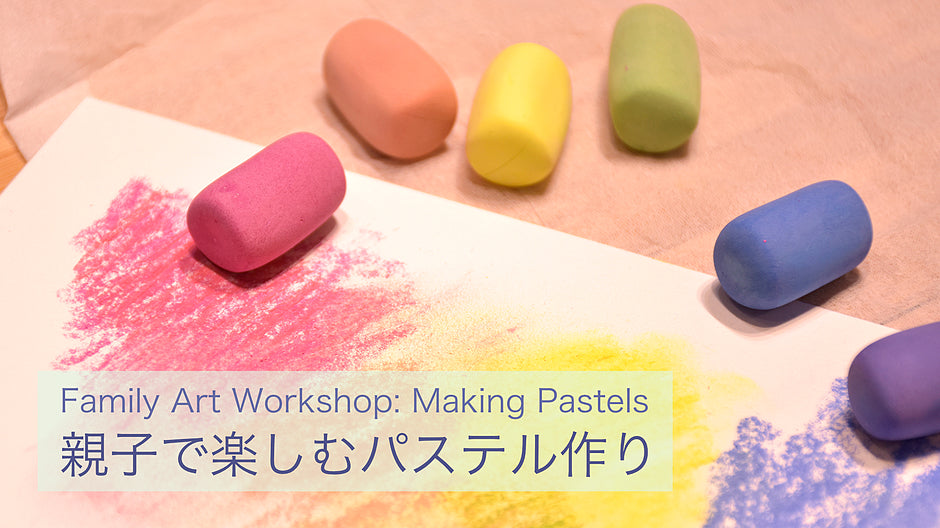*This event has ended.
Find the latest information about our workshops here.
PIGMENT TOKYO has held several workshops for parents and children to spend time together especially during the summer break.
This summer, "Pastel Making" was added to the list.
Even though it is a program mainly for children, the content and materials are not just for kids to fool around. In the "Crayon Making" workshop held during Golden Week, there were times when the adults were more excited than the children, and there were even moments when the kids would give some advice to the adults.
I wonder how many of you are familiar with what pastels are?
The term "pastel tones" is sometimes used to describe bright, subtle colors with low saturation, however, pastels do not always appear subtle.
The biggest difference between crayons and pastels is in their fixability.
Crayons are made by kneading extender pigments and wax or paraffin that function as binders.
This means that once a drawing is done, it is firmly fixed on the surface but at the same time, it is not suitable for color layering or overlapping.

A comparison of oil pastels made by Sennelier (left), which contain oil-based binders, and soft pastels (Gondola Pastels) made by Ohkan Kagaku Kogyosho (right).
If we take a closer look, you can tell that the oil pastel has more viscous brushstrokes. When I rubbed them with my fingers to blend the colors, the soft pastels had more particles spread out which created a softer tone.
Soft pastels are mainly composed of pigments, extenders and a small amount of water-based fixing agents. Therefore, it’s almost impossible to draw lines with strong edges like with crayons, however, spreading them gently with your fingers after drawing on the paper, creates a light shade that blends well with the paper.
Furthermore, since the pastels are excellent for blending colors on the paper surface, they give us a great experience as we mix paints on a palette, the pastels would also bring us some fun like asking ourselves, "What kind of color will I get if I mix yellow and blue?" or " How about mixing red and green? "

I experimented with pastels by adding some water with a brush and adding more colors.
In addition to these features, you may also find the advantages of pastels from a child's point of view, such as finding the differences and mixing the pastels with crayons used at school, buying more of your favorite pigments to make your own pastels or using them with watercolors!
Click the entry page below if you’re interested in learning more!
Family Art Workshop: Creating Original Pastels

Date: 2021/08/01(Sunday)
Time: 10:30 - 12:00
Fee: 6,600 yen (tax included)
Reservation: https://pigment.tokyo/en/products/363
※This ticket is for a pair of a parent and a child.
※Please do not attend with only one adult or only two adults.
*This event has ended.
Find the latest information about our workshops here.
https://pigment.tokyo/en/collections/workshop
This pastel-making workshop is also available online via Zoom.
This course is open to all ages and the fee is for one person.
If you add a set of art materials as an option, parents can also enjoy this online workshop with your children together.
[Live Streaming] Pastel Making

Date: 2021/08/09 (Monday, National Holiday)
Time: 10:30 - 12:00
Fee: 5,500 yen (tax included)
Reservation: https://pigment.tokyo/en/products/364
Please check the entry form for information on how to watch and how to order art supplies.
*This event has ended.
Find the latest information about our workshops here.
https://pigment.tokyo/en/collections/workshop
We will also like to introduce our annual event, which is perfect for children's school projects.
Family Art Workshop: Creating Original Color Wheel

Date: 2021/07/23 (Friday, National Holiday)
Time: 10:30 - 12:30
Fee: 6,600 yen (tax included)
Reservation: https://pigment.tokyo/en/products/361(Ticket sold out)
*This event has ended.
Find the latest information about our workshops here.
https://pigment.tokyo/en/collections/workshop
Learning Japanese Traditional Art Materials

Date: 2021/08/08 (Sunday)
Time: 10:30 - 12:30
Fee: 6,600 yen (tax included)
Reservation: https://pigment.tokyo/en/products/362
*This event has ended.
Find the latest information about our workshops here.
https://pigment.tokyo/en/collections/workshop
At WHAT CAFE, located next to PIGMENT TOKYO, you can enjoy having lunch surrounded by some contemporary artists’ latest artworks.
Therefore, you could spend the rest of your afternoon after the workshop along the canals of Tennoz Isle.

The picture above is a pasta set that comes with daily specials for 1,000 yen (tax included), and you can add another 100 yen for a lunch dessert (tax included).
There is also a barista's coffee special available from 400 yen (tax included).
For more information, please visit the cafe's website.
https://cafe.warehouseofart.org/
*This event has ended.
If you are skipping the long trip and decided to stay within the Kanto area, how about spending an artsy time in Tennoz Isle this summer?

